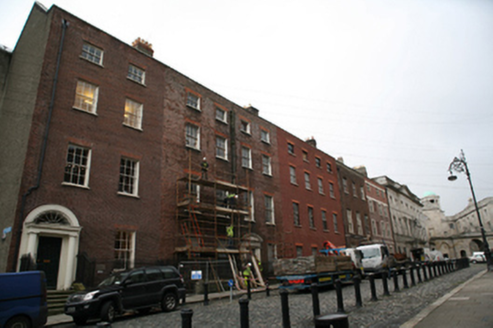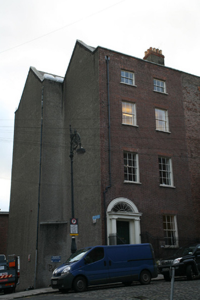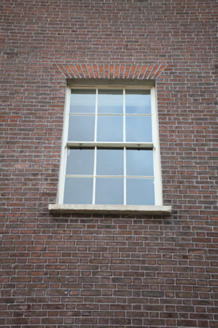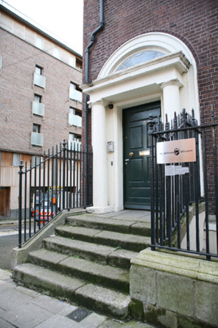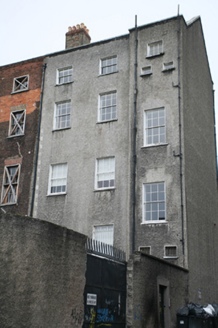Survey Data
Reg No
50010674
Rating
Regional
Categories of Special Interest
Architectural, Artistic, Cultural
Original Use
House
In Use As
Community centre
Date
1730 - 1770
Coordinates
315249, 234938
Date Recorded
08/12/2011
Date Updated
--/--/--
Description
End-of-terrace two-bay four-storey house over exposed basement, built c.1750, formerly four bays, eastern bays demolished 1950. Double-gabled east side elevation. Now in office use. M-profile slate roof with replacement granite coping to both gables. Roof hidden behind parapet wall with replacement granite coping and replacement cast-iron hopper and downpipe breaking through to east. Further cast-iron hopper and downpipe breaking through to rear gable. Brown brick chimneystack to west party wall with red brick coping and clay pots. Red brick walls laid in Flemish bond with recent lime tuck-pointing and wigging. Chamfered granite plinth course over painted rendered basement walls. Roughcast rendered walls to rear and east gabled elevations. Gauged brick flat-arched window openings with flush rendered reveals, Portland stone sills and replacement timber sliding sash windows throughout, six-over-six pane to lower floors and three-over-three pane to top floor. Gauged brick round-headed door opening with moulded masonry surround and painted stone advanced Doric doorcase. Replacement timber door with six raised-and-fielded panels, simple architrave surround two Doric columns on square plinth bases supporting full entablature with cornice and replacement cobweb fanlight. Door opens onto granite platform with partial cast-iron bootscraper and five granite steps bridging basement. Platform and basement enclosed by wrought-iron railings with cast-iron finials to corners set on moulded granite plinth wall and matching iron gate giving access to basement via steel steps. Roughcast rendered wall encloses rear garden with steel gate onto Henrietta Place.
Appraisal
Like many of the houses on the street this house was originally four bays wide, the east half having been demolished in the mid-twentieth century, leaving an empty site onto Henrietta Place. The street, laid out by Luke Gardiner in the 1720s, is a cul-de-sac containing the finest early Georgian houses in the city. Named after Henrietta Crofts, the third wife of Charles Paulet, 2nd Duke of Bolton and Lord Lieutenant in 1717-21, the street developed in a piecemeal fashion and set the trends of scale and design in domestic architecture. Recently restored, the house has had most materials sensitively reinstated, while Dublin City Council recently held a design competition for an infill development of the empty site. Terminating the east end of the south side of the street, the house forms part of what has been described as 'Dublin’s Street of Palaces' with the recent restoration contributing to the improving fortunes of this remarkable streetscape.
